5G集成相控阵天线:设计,制造和测试
- 格式:pdf
- 大小:2.29 MB
- 文档页数:11
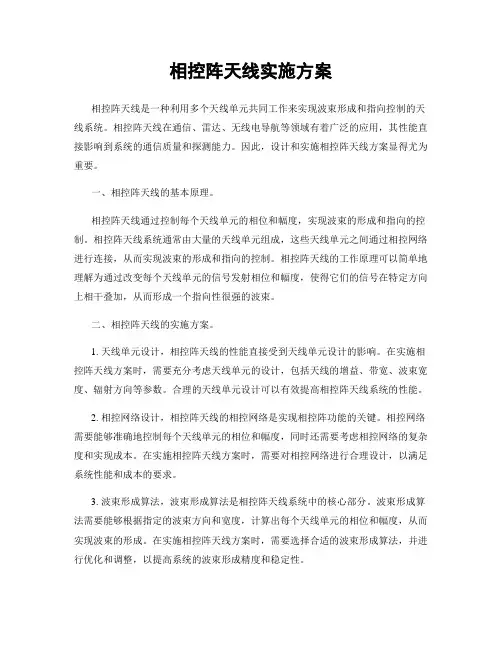
相控阵天线实施方案相控阵天线是一种利用多个天线单元共同工作来实现波束形成和指向控制的天线系统。
相控阵天线在通信、雷达、无线电导航等领域有着广泛的应用,其性能直接影响到系统的通信质量和探测能力。
因此,设计和实施相控阵天线方案显得尤为重要。
一、相控阵天线的基本原理。
相控阵天线通过控制每个天线单元的相位和幅度,实现波束的形成和指向的控制。
相控阵天线系统通常由大量的天线单元组成,这些天线单元之间通过相控网络进行连接,从而实现波束的形成和指向的控制。
相控阵天线的工作原理可以简单地理解为通过改变每个天线单元的信号发射相位和幅度,使得它们的信号在特定方向上相干叠加,从而形成一个指向性很强的波束。
二、相控阵天线的实施方案。
1. 天线单元设计,相控阵天线的性能直接受到天线单元设计的影响。
在实施相控阵天线方案时,需要充分考虑天线单元的设计,包括天线的增益、带宽、波束宽度、辐射方向等参数。
合理的天线单元设计可以有效提高相控阵天线系统的性能。
2. 相控网络设计,相控阵天线的相控网络是实现相控阵功能的关键。
相控网络需要能够准确地控制每个天线单元的相位和幅度,同时还需要考虑相控网络的复杂度和实现成本。
在实施相控阵天线方案时,需要对相控网络进行合理设计,以满足系统性能和成本的要求。
3. 波束形成算法,波束形成算法是相控阵天线系统中的核心部分。
波束形成算法需要能够根据指定的波束方向和宽度,计算出每个天线单元的相位和幅度,从而实现波束的形成。
在实施相控阵天线方案时,需要选择合适的波束形成算法,并进行优化和调整,以提高系统的波束形成精度和稳定性。
4. 系统集成与调试,相控阵天线系统的实施不仅包括硬件设计和制造,还包括系统集成和调试。
在实施相控阵天线方案时,需要对系统进行全面的集成和调试,包括硬件和软件的调试、系统性能的测试和验证等工作,以确保系统能够正常工作并满足设计要求。
5. 性能评估与优化,相控阵天线系统的实施并不是一次性的工作,还需要对系统的性能进行评估和优化。
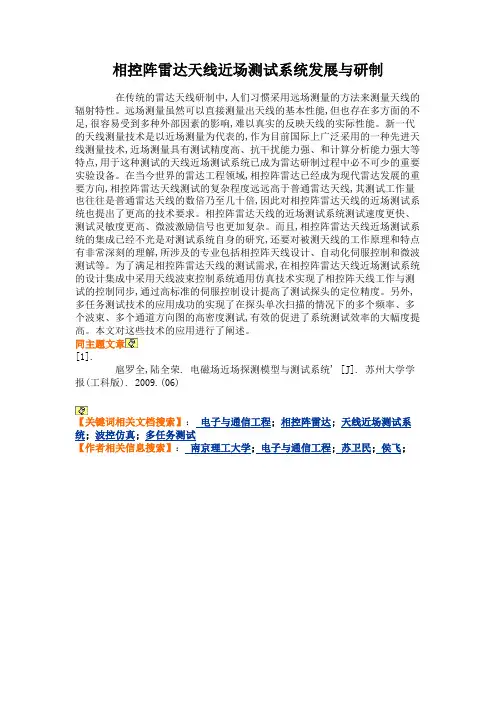
相控阵雷达天线近场测试系统发展与研制在传统的雷达天线研制中,人们习惯采用远场测量的方法来测量天线的辐射特性。
远场测量虽然可以直接测量出天线的基本性能,但也存在多方面的不足,很容易受到多种外部因素的影响,难以真实的反映天线的实际性能。
新一代的天线测量技术是以近场测量为代表的,作为目前国际上广泛采用的一种先进天线测量技术,近场测量具有测试精度高、抗干扰能力强、和计算分析能力强大等特点,用于这种测试的天线近场测试系统已成为雷达研制过程中必不可少的重要实验设备。
在当今世界的雷达工程领域,相控阵雷达已经成为现代雷达发展的重要方向,相控阵雷达天线测试的复杂程度远远高于普通雷达天线,其测试工作量也往往是普通雷达天线的数倍乃至几十倍,因此对相控阵雷达天线的近场测试系统也提出了更高的技术要求。
相控阵雷达天线的近场测试系统测试速度更快、测试灵敏度更高、微波激励信号也更加复杂。
而且,相控阵雷达天线近场测试系统的集成已经不光是对测试系统自身的研究,还要对被测天线的工作原理和特点有非常深刻的理解,所涉及的专业包括相控阵天线设计、自动化伺服控制和微波测试等。
为了满足相控阵雷达天线的测试需求,在相控阵雷达天线近场测试系统的设计集成中采用天线波束控制系统通用仿真技术实现了相控阵天线工作与测试的控制同步,通过高标准的伺服控制设计提高了测试探头的定位精度。
另外,多任务测试技术的应用成功的实现了在探头单次扫描的情况下的多个频率、多个波束、多个通道方向图的高密度测试,有效的促进了系统测试效率的大幅度提高。
本文对这些技术的应用进行了阐述。
同主题文章[1].扈罗全,陆全荣. 电磁场近场探测模型与测试系统' [J]. 苏州大学学报(工科版). 2009.(06)【关键词相关文档搜索】:电子与通信工程; 相控阵雷达; 天线近场测试系统; 波控仿真; 多任务测试【作者相关信息搜索】:南京理工大学;电子与通信工程;苏卫民;侯飞;。
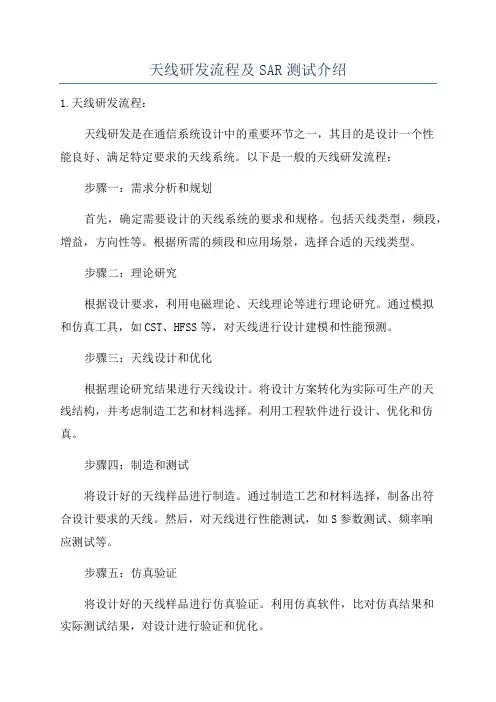
天线研发流程及SAR测试介绍1.天线研发流程:天线研发是在通信系统设计中的重要环节之一,其目的是设计一个性能良好、满足特定要求的天线系统。
以下是一般的天线研发流程:步骤一:需求分析和规划首先,确定需要设计的天线系统的要求和规格。
包括天线类型,频段,增益,方向性等。
根据所需的频段和应用场景,选择合适的天线类型。
步骤二:理论研究根据设计要求,利用电磁理论、天线理论等进行理论研究。
通过模拟和仿真工具,如CST、HFSS等,对天线进行设计建模和性能预测。
步骤三:天线设计和优化根据理论研究结果进行天线设计。
将设计方案转化为实际可生产的天线结构,并考虑制造工艺和材料选择。
利用工程软件进行设计、优化和仿真。
步骤四:制造和测试将设计好的天线样品进行制造。
通过制造工艺和材料选择,制备出符合设计要求的天线。
然后,对天线进行性能测试,如S参数测试、频率响应测试等。
步骤五:仿真验证将设计好的天线样品进行仿真验证。
利用仿真软件,比对仿真结果和实际测试结果,对设计进行验证和优化。
步骤六:验证和集成对设计好的天线样品进行验证,与实际系统进行集成测试。
根据集成测试的结果,对设计进行修正和调整。
步骤七:量产和市场应用最后,进行天线的大规模制造和量产。
将天线产品应用于各种通信系统中。
2.SAR测试介绍:SAR(Specific Absorption Rate)是一种测量电磁波对人体吸收的量化指标。
它表示单位质量或单位体积组织吸收的电磁能量。
SAR测试是为了评估电磁波对人体的生物效应和安全性。
SAR测试是使用模型人体进行的,该模型人体具有与真实人体相似的尺寸和电性参数。
测试过程中,将模型人体与天线系统进行完全或部分接触,通过测量模型人体吸收的电磁能量来计算SAR值。
SAR测试通常包括以下步骤:步骤一:建立模型人体使用具有标准尺寸和电性参数的人体模型,如美国联邦通信委员会(FCC)的具有特定体积和电导率的模型。
步骤二:测量电磁场在模型人体附近,使用测量设备(如探针、场强计等)测量天线系统辐射的电磁场值。

2024年相控阵培训计划引言随着科技的快速发展,相控阵技术在军事、航空航天、通信等领域得到了广泛应用。
为了提升我国在相控阵领域的技术实力,我国计划在2024年推出一项相控阵培训计划,旨在培养更多的专业人才,推动相控阵技术的发展。
培训目标本培训计划旨在培养具有相控阵工作经验和能力的高级工程技术人才,为我国相控阵技术的发展注入新的动力。
具体培训目标包括但不限于: - 掌握相控阵基本原理和关键技术 - 熟悉相控阵系统设计与实施 - 具备相控阵系统调试和维护能力 - 能够独立进行相控阵系统的研发和创新培训内容阶段一:理论学习(3个月)1.相控阵基本原理与技术概述2.相控阵系统组成与工作原理3.相控阵天线设计与制造4.相控阵信号处理与数据分析阶段二:实践操作(4个月)1.相控阵系统搭建与调试2.相控阵系统运行与维护3.相控阵系统性能优化与改进4.相控阵系统在实际应用中的模拟演练阶段三:项目实践(5个月)1.参与实际相控阵项目的设计与开发2.完成相控阵项目的实施与调试3.提出相控阵项目的改进建议与优化方案4.撰写相控阵项目总结报告培训方式本培训计划主要采取面授与实践相结合的方式进行,培训期间还将安排专业教师进行授课指导、实际项目指导以及实际情境模拟等形式帮助学员提升相关技能。
培训学员将分成若干个小组,每个小组由一名专业教师指导,督导学员完成相关任务。
培训要求为了保证培训效果,我们要求培训学员需要具备以下条件: 1. 本科及以上学历,电子工程、通信工程等相关专业背景; 2. 具备一定的电子技术基础知识,有一定的项目经验者优先; 3. 对相控阵技术有浓厚的兴趣和热情,能够全身心投入到培训中。
结语通过本次相控阵培训计划,我们将为我国培养更多的相控阵技术人才,推动我国相控阵技术的长足发展,为我国在科技领域的竞争力提升贡献一份力量。
以上是2024年相控阵培训计划的具体内容,希望广大对相控阵技术感兴趣的同学们积极报名参加,共同推动我国相控阵技术的发展。
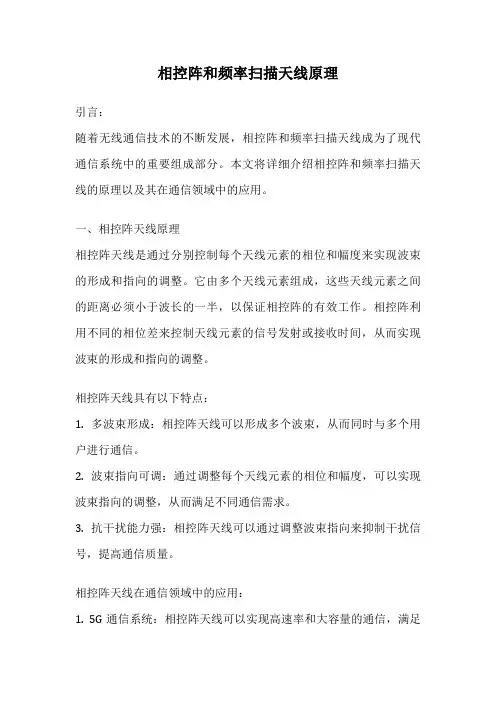
相控阵和频率扫描天线原理引言:随着无线通信技术的不断发展,相控阵和频率扫描天线成为了现代通信系统中的重要组成部分。
本文将详细介绍相控阵和频率扫描天线的原理以及其在通信领域中的应用。
一、相控阵天线原理相控阵天线是通过分别控制每个天线元素的相位和幅度来实现波束的形成和指向的调整。
它由多个天线元素组成,这些天线元素之间的距离必须小于波长的一半,以保证相控阵的有效工作。
相控阵利用不同的相位差来控制天线元素的信号发射或接收时间,从而实现波束的形成和指向的调整。
相控阵天线具有以下特点:1. 多波束形成:相控阵天线可以形成多个波束,从而同时与多个用户进行通信。
2. 波束指向可调:通过调整每个天线元素的相位和幅度,可以实现波束指向的调整,从而满足不同通信需求。
3. 抗干扰能力强:相控阵天线可以通过调整波束指向来抑制干扰信号,提高通信质量。
相控阵天线在通信领域中的应用:1. 5G通信系统:相控阵天线可以实现高速率和大容量的通信,满足5G通信系统对于高速率和大容量的需求。
2. 雷达系统:相控阵天线可以实现雷达的目标跟踪和探测,提高雷达系统的性能。
3. 卫星通信系统:相控阵天线可以实现卫星通信系统的波束指向调整,提高通信质量和覆盖范围。
二、频率扫描天线原理频率扫描天线是通过改变天线的工作频率来实现波束指向的调整。
频率扫描天线根据天线的工作频率不同,可以实现不同方向的波束指向。
通过改变工作频率,可以实现波束的快速调整和切换。
频率扫描天线具有以下特点:1. 快速调整:通过改变工作频率,可以实现波束的快速调整和切换,适应不同通信需求。
2. 灵活性高:频率扫描天线可以根据需求改变工作频率,实现波束指向的调整,提高通信质量。
3. 多方向覆盖:频率扫描天线可以实现多个方向的波束指向,提高通信系统的覆盖范围。
频率扫描天线在通信领域中的应用:1. 移动通信系统:频率扫描天线可以实现移动通信系统的快速切换和调整,提高通信质量和覆盖范围。
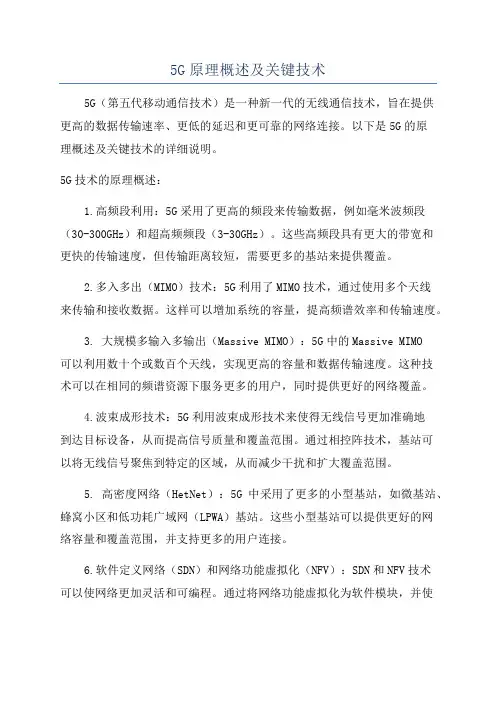
5G原理概述及关键技术5G(第五代移动通信技术)是一种新一代的无线通信技术,旨在提供更高的数据传输速率、更低的延迟和更可靠的网络连接。
以下是5G的原理概述及关键技术的详细说明。
5G技术的原理概述:1.高频段利用:5G采用了更高的频段来传输数据,例如毫米波频段(30-300GHz)和超高频频段(3-30GHz)。
这些高频段具有更大的带宽和更快的传输速度,但传输距离较短,需要更多的基站来提供覆盖。
2.多入多出(MIMO)技术:5G利用了MIMO技术,通过使用多个天线来传输和接收数据。
这样可以增加系统的容量,提高频谱效率和传输速度。
3. 大规模多输入多输出(Massive MIMO):5G中的Massive MIMO可以利用数十个或数百个天线,实现更高的容量和数据传输速度。
这种技术可以在相同的频谱资源下服务更多的用户,同时提供更好的网络覆盖。
4.波束成形技术:5G利用波束成形技术来使得无线信号更加准确地到达目标设备,从而提高信号质量和覆盖范围。
通过相控阵技术,基站可以将无线信号聚焦到特定的区域,从而减少干扰和扩大覆盖范围。
5. 高密度网络(HetNet):5G中采用了更多的小型基站,如微基站、蜂窝小区和低功耗广域网(LPWA)基站。
这些小型基站可以提供更好的网络容量和覆盖范围,并支持更多的用户连接。
6.软件定义网络(SDN)和网络功能虚拟化(NFV):SDN和NFV技术可以使网络更加灵活和可编程。
通过将网络功能虚拟化为软件模块,并使用SDN来建立和管理网络流量,可以更高效地使用网络资源,并根据需求快速调整网络配置。
7.边缘计算:5G可以通过在网络边缘(如基站或边缘服务器)上进行计算和存储,减少了与云服务器的通信延迟,并为低时延应用提供更好的支持。
8.虚拟多路径:5G可以通过利用多个传输路径来提高网络的可靠性和安全性。
当一个路径受到干扰或中断时,系统可以自动切换到其他路径,确保用户的无缝连接。
9. 超小区:5G中引入了超小区(Ultra-dense networks),意味着更多的基站被部署在相同的区域内,以提供更强的信号覆盖和更高的网络容量。
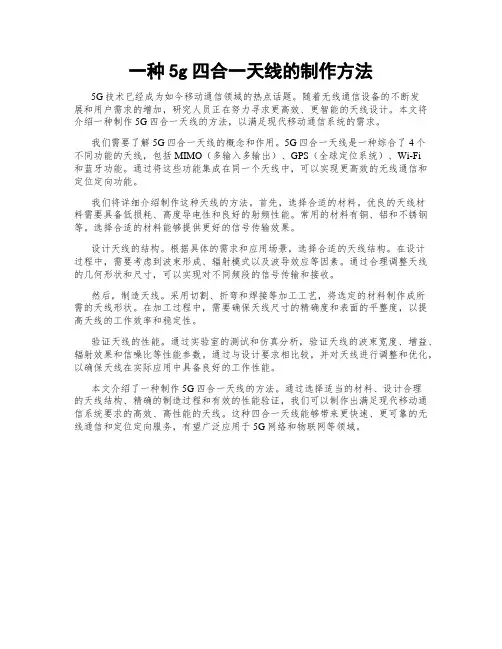
一种5g四合一天线的制作方法5G技术已经成为如今移动通信领域的热点话题。
随着无线通信设备的不断发展和用户需求的增加,研究人员正在努力寻求更高效、更智能的天线设计。
本文将介绍一种制作5G四合一天线的方法,以满足现代移动通信系统的需求。
我们需要了解5G四合一天线的概念和作用。
5G四合一天线是一种综合了4个不同功能的天线,包括MIMO(多输入多输出)、GPS(全球定位系统)、Wi-Fi和蓝牙功能。
通过将这些功能集成在同一个天线中,可以实现更高效的无线通信和定位定向功能。
我们将详细介绍制作这种天线的方法。
首先,选择合适的材料。
优良的天线材料需要具备低损耗、高度导电性和良好的射频性能。
常用的材料有铜、铝和不锈钢等。
选择合适的材料能够提供更好的信号传输效果。
设计天线的结构。
根据具体的需求和应用场景,选择合适的天线结构。
在设计过程中,需要考虑到波束形成、辐射模式以及波导效应等因素。
通过合理调整天线的几何形状和尺寸,可以实现对不同频段的信号传输和接收。
然后,制造天线。
采用切割、折弯和焊接等加工工艺,将选定的材料制作成所需的天线形状。
在加工过程中,需要确保天线尺寸的精确度和表面的平整度,以提高天线的工作效率和稳定性。
验证天线的性能。
通过实验室的测试和仿真分析,验证天线的波束宽度、增益、辐射效果和信噪比等性能参数。
通过与设计要求相比较,并对天线进行调整和优化,以确保天线在实际应用中具备良好的工作性能。
本文介绍了一种制作5G四合一天线的方法。
通过选择适当的材料、设计合理的天线结构、精确的制造过程和有效的性能验证,我们可以制作出满足现代移动通信系统要求的高效、高性能的天线。
这种四合一天线能够带来更快速、更可靠的无线通信和定位定向服务,有望广泛应用于5G网络和物联网等领域。
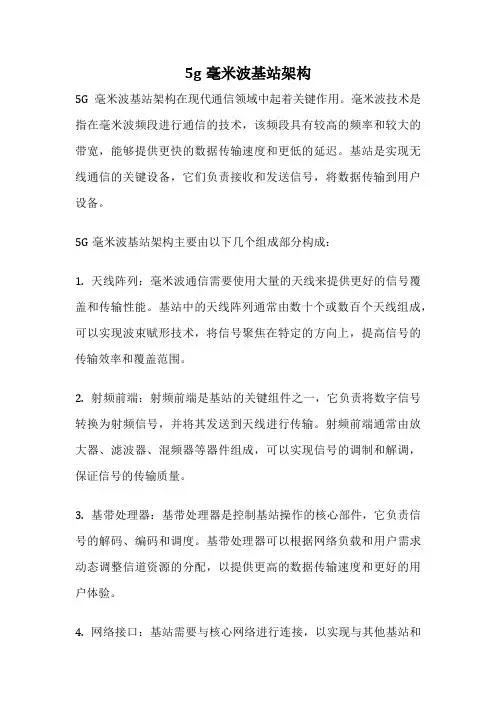
5g毫米波基站架构5G毫米波基站架构在现代通信领域中起着关键作用。
毫米波技术是指在毫米波频段进行通信的技术,该频段具有较高的频率和较大的带宽,能够提供更快的数据传输速度和更低的延迟。
基站是实现无线通信的关键设备,它们负责接收和发送信号,将数据传输到用户设备。
5G毫米波基站架构主要由以下几个组成部分构成:1. 天线阵列:毫米波通信需要使用大量的天线来提供更好的信号覆盖和传输性能。
基站中的天线阵列通常由数十个或数百个天线组成,可以实现波束赋形技术,将信号聚焦在特定的方向上,提高信号的传输效率和覆盖范围。
2. 射频前端:射频前端是基站的关键组件之一,它负责将数字信号转换为射频信号,并将其发送到天线进行传输。
射频前端通常由放大器、滤波器、混频器等器件组成,可以实现信号的调制和解调,保证信号的传输质量。
3. 基带处理器:基带处理器是控制基站操作的核心部件,它负责信号的解码、编码和调度。
基带处理器可以根据网络负载和用户需求动态调整信道资源的分配,以提供更高的数据传输速度和更好的用户体验。
4. 网络接口:基站需要与核心网络进行连接,以实现与其他基站和用户设备的通信。
网络接口通常使用光纤或以太网进行传输,可以实现高速数据传输和低延迟的通信。
5. 辅助设备:为了确保基站的正常运行,还需要配备一些辅助设备,如电源供应系统、温控系统和安全监控系统等。
这些设备可以提供稳定的电力供应、保持基站的温度和环境适宜,并确保基站的安全运行。
5G毫米波基站架构是一个复杂的系统工程,它的设计和部署需要考虑多个因素,如信号传输距离、信号传输速度、信号覆盖范围等。
通过合理的设计和优化,可以实现更高效、更快速、更可靠的无线通信服务,为人们的生活和工作带来更多便利和可能性。
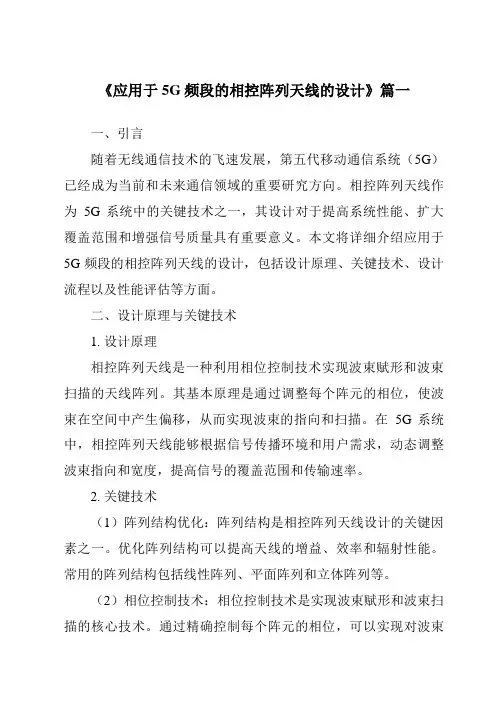
《应用于5G频段的相控阵列天线的设计》篇一一、引言随着无线通信技术的飞速发展,第五代移动通信系统(5G)已经成为当前和未来通信领域的重要研究方向。
相控阵列天线作为5G系统中的关键技术之一,其设计对于提高系统性能、扩大覆盖范围和增强信号质量具有重要意义。
本文将详细介绍应用于5G频段的相控阵列天线的设计,包括设计原理、关键技术、设计流程以及性能评估等方面。
二、设计原理与关键技术1. 设计原理相控阵列天线是一种利用相位控制技术实现波束赋形和波束扫描的天线阵列。
其基本原理是通过调整每个阵元的相位,使波束在空间中产生偏移,从而实现波束的指向和扫描。
在5G系统中,相控阵列天线能够根据信号传播环境和用户需求,动态调整波束指向和宽度,提高信号的覆盖范围和传输速率。
2. 关键技术(1)阵列结构优化:阵列结构是相控阵列天线设计的关键因素之一。
优化阵列结构可以提高天线的增益、效率和辐射性能。
常用的阵列结构包括线性阵列、平面阵列和立体阵列等。
(2)相位控制技术:相位控制技术是实现波束赋形和波束扫描的核心技术。
通过精确控制每个阵元的相位,可以实现对波束的指向和扫描。
常用的相位控制技术包括数字式相位控制技术和模拟式相位控制技术。
(3)信号处理技术:信号处理技术是提高相控阵列天线性能的重要手段。
通过对接收到的信号进行滤波、放大、采样和数字处理等操作,可以提高信号的信噪比和传输速率。
三、设计流程1. 需求分析:根据5G系统的需求,确定相控阵列天线的性能指标和工作频段。
2. 阵列结构设计与仿真:根据需求分析结果,设计出满足要求的阵列结构,并进行仿真验证。
3. 相位控制技术与信号处理技术研究:研究并确定合适的相位控制技术和信号处理技术。
4. 天线单元设计与优化:设计出满足要求的天线单元,并进行优化设计。
5. 整体设计与仿真:将天线单元与阵列结构进行整合,进行整体设计与仿真验证。
6. 制作与测试:根据仿真结果,制作出实物样品并进行测试验证。

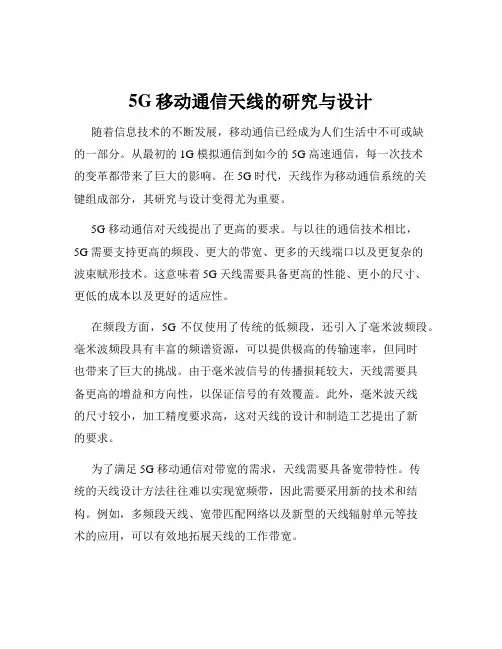
5G移动通信天线的研究与设计随着信息技术的不断发展,移动通信已经成为人们生活中不可或缺的一部分。
从最初的 1G 模拟通信到如今的 5G 高速通信,每一次技术的变革都带来了巨大的影响。
在 5G 时代,天线作为移动通信系统的关键组成部分,其研究与设计变得尤为重要。
5G 移动通信对天线提出了更高的要求。
与以往的通信技术相比,5G 需要支持更高的频段、更大的带宽、更多的天线端口以及更复杂的波束赋形技术。
这意味着 5G 天线需要具备更高的性能、更小的尺寸、更低的成本以及更好的适应性。
在频段方面,5G 不仅使用了传统的低频段,还引入了毫米波频段。
毫米波频段具有丰富的频谱资源,可以提供极高的传输速率,但同时也带来了巨大的挑战。
由于毫米波信号的传播损耗较大,天线需要具备更高的增益和方向性,以保证信号的有效覆盖。
此外,毫米波天线的尺寸较小,加工精度要求高,这对天线的设计和制造工艺提出了新的要求。
为了满足 5G 移动通信对带宽的需求,天线需要具备宽带特性。
传统的天线设计方法往往难以实现宽频带,因此需要采用新的技术和结构。
例如,多频段天线、宽带匹配网络以及新型的天线辐射单元等技术的应用,可以有效地拓展天线的工作带宽。
在天线端口数量方面,5G 采用了大规模多输入多输出(MIMO)技术,天线端口数量大幅增加。
这要求天线能够实现多个端口之间的良好隔离,以避免信号之间的干扰。
同时,大规模 MIMO 技术需要天线能够灵活地调整波束方向,实现对用户的精准覆盖和跟踪,这就需要采用先进的波束赋形算法和天线阵列设计。
5G 移动通信天线的设计面临着诸多技术难题。
首先是天线的小型化问题。
随着移动设备的轻薄化发展,天线的尺寸受到了严格的限制。
如何在有限的空间内实现高性能的天线是一个亟待解决的问题。
其次是天线的集成化问题。
5G 通信系统需要将天线与射频前端、基带处理等模块集成在一起,以实现系统的小型化和高性能。
这就需要解决天线与其他模块之间的电磁兼容问题,以及优化整个系统的性能。
相控阵天线功能相控阵天线(Phased Array Antenna)是一种具有高度方向性和灵活可调的天线系统,广泛应用于通信、雷达、无人机、卫星通信和军事防御等领域。
相控阵天线通过对天线元件的相位和幅度进行精确控制,可以实现信号的波束形成、波束指向调整和波束宽度控制等功能,从而提高通信质量和系统性能。
相控阵天线由多个天线元件组成,每个天线元件之间存在一定的间距和相位差,通过合理的控制这些参数,可以使得天线阵列在特定方向上形成一个主瓣,同时抑制其他方向的干扰信号。
相控阵天线可以通过调整天线元件的相位和幅度来改变主瓣的指向,从而实现波束的电子扫描,而无需进行机械调整。
这种电子扫描的方式具有快速、精确和灵活的特点,能够满足不同场景下的通信和探测要求。
相控阵天线的核心技术是相控阵信号处理,即通过计算和调整天线元件的相位和幅度来实现波束形成和指向调整。
在相控阵信号处理中,需要进行波束形成算法的设计和实现。
常见的波束形成算法包括线性加权法、最小均方误差法(MVDR)、协方差矩阵差分法(CMDF)等。
这些算法可以通过优化天线元件的相位和幅度权重,使得波束在目标方向上具有最大增益,从而实现有效的信号接收和传输。
相控阵天线除了可以实现波束形成和指向调整外,还可以通过调整天线元件的相位和幅度来控制波束的宽度。
波束的宽度决定了天线的覆盖范围和信号接收的灵敏度。
在通信系统中,可以根据用户的位置和通信要求,动态调整波束的宽度,以提高通信质量和系统容量。
在雷达和无人机应用中,可以根据目标的距离和速度,调整波束的宽度,以实现目标的跟踪和探测。
相控阵天线的优势在于其具有高度方向性和灵活可控的特点。
相较于传统的机械扫描天线,相控阵天线不需要进行机械调整,可以实现快速、精确和灵活的波束形成和指向调整。
相控阵天线还具有抗干扰能力强、系统可靠性高、功耗低等优点。
因此,相控阵天线在现代通信和雷达系统中得到了广泛的应用和研究。
总结起来,相控阵天线是一种具有高度方向性和灵活可调的天线系统,通过对天线元件的相位和幅度进行精确控制,实现了波束形成、波束指向调整和波束宽度控制等功能。
超宽带天线与相控阵天线系统研究一、概述随着无线通信技术的飞速发展,超宽带天线与相控阵天线系统在现代通信、雷达、电子战等领域的应用日益广泛。
超宽带天线以其独特的宽频带特性和高分辨率能力,在无线通信、短距离高速数据传输等方面具有显著优势。
而相控阵天线系统则以其灵活的波束指向、快速扫描和抗干扰能力,在雷达探测、卫星通信、电子侦察等领域发挥着重要作用。
对超宽带天线与相控阵天线系统的深入研究,不仅有助于推动无线通信技术的发展,也对提高我国国防实力和国民经济水平具有重要意义。
本文旨在全面系统地探讨超宽带天线与相控阵天线系统的基本原理、设计方法、性能优化及应用前景。
我们将介绍超宽带天线和相控阵天线的基本概念和原理,包括天线的辐射特性、波束形成和波束控制等。
在此基础上,我们将重点讨论超宽带天线和相控阵天线的关键设计技术,如天线阵列的优化布局、波束赋形算法、信号处理技术等。
同时,我们还将分析超宽带天线与相控阵天线在不同应用场景下的性能表现和潜在问题,并提出相应的优化策略。
我们将展望超宽带天线与相控阵天线系统的未来发展趋势,探讨新技术、新材料和新工艺在天线设计中的应用前景,以及天线系统在5G通信、物联网、卫星互联网等领域的潜在应用。
通过本文的研究,我们期望能够为超宽带天线与相控阵天线系统的设计和应用提供有益的参考和指导。
1. 介绍超宽带天线与相控阵天线系统的研究背景和意义随着无线通信技术的飞速发展和广泛应用,天线作为无线通信系统的关键组件,其性能与设计的优化对于提升整个通信系统的性能具有至关重要的作用。
超宽带(UWB)天线与相控阵天线系统作为其中的重要研究方向,近年来受到了广泛的关注和研究。
超宽带天线技术以其高数据传输速率、低功耗和抗干扰能力强等特点,在雷达、无线通信、电子战等领域展现出广阔的应用前景。
超宽带天线具有极宽的带宽和极短的脉冲持续时间,这使得其能够在高速数据传输和精确定位方面实现优异的性能。
超宽带天线的设计和实现面临诸多挑战,如天线的小型化、宽带化、低剖面化等,这些问题的解决对于推动超宽带技术的应用具有重要意义。
相控阵天线设计方案一、相控阵天线需求分析1.天线应用场景图1-(a)图1-(b)如图1所示,定义XOY平面为天线安装面,天线采用平板结构外形,与天花板共形安装。
为了实现AP的远距离覆盖能力,天线需要在天花板平面具备高增益特性;在AP的高密度部署区域,需要天线波束集中于垂直向下区域,同时窄波束有利于降低AP之间的相互干扰。
由此可知,天线需要具备高增益、大角度覆盖的能力。
2.天线指标要求图25G频段:4.9GHz~5.9GHz在xz/yz面:第一档:theta=90°增益大于5dB第二档:theta=90°增益比第一档增益下降4dB第三档:theta=90°/-90°增益小于-9dBtheta=60°/-60°增益小于-6dB2.4G频段:2.4GHz~2.49GHz在xz/yz面:第一档:theta=90°增益大于3dB第二档:theta=90°增益比第一档增益下降4dB第三档:theta=90°/-90°增益小于-9dBtheta=60°/-60°增益小于-6dB根据图2坐标定义,天线波束需要具备在±90°角度内满足大角度、高增益扫描状态。
图3根据图3阵列布局要求,每个天线子阵采用线阵形式,各自覆盖俯仰0°~90°角度,最终实现整阵对于下半空间的全覆盖。
二、天线设计方案阵列天线的大角度扫描是阵列天线设计的一大难点。
从理论上讲阵列的天线增益满足:阵列增益=单元增益+阵因子增益,天线单元的广角辐射特性决定了阵列波束的宽角扫描特性。
当阵列主波束扫描时,随着扫描角度的不同,其增益也在天线单元方向图的限制范围内改变。
当阵列波束扫描至天线单元的增益降至-3dB 的角度时,阵列增益将减小-3dB。
因此,天线单元的3dB 波束覆盖范围,也是阵列的3dB 波束扫描范围。
相控阵天线关键技术的研究相控阵天线是一种具有广泛应用前景的无线通信技术,其性能的优劣直接影响到无线通信系统的性能。
本文主要对相控阵天线的关键技术进行研究,以期为提高相控阵天线的性能提供理论支持和实践指导。
在相控阵天线中,阵元排列、信号处理及数字信号处理等关键技术起着至关重要的作用。
阵元排列方式的优劣直接影响到天线的方向性、增益等性能。
常见的阵元排列方式包括直线阵、平面阵和立体阵等,不同的排列方式有各自的优势和适用场景。
信号处理技术是相控阵天线的核心,其处理能力的强弱直接影响着天线的性能。
数字信号处理技术作为现代信号处理技术的代表,具有高精度、高稳定性和高灵活性等优点,在相控阵天线中得到广泛应用。
为了深入研究相控阵天线的关键技术,我们采用了多种研究方法。
我们对国内外相关文献进行调研,了解相控阵天线技术的最新研究动态和前沿技术。
同时,我们进行实地调查,对各种应用场景下的相控阵天线进行测试和分析,掌握第一手数据。
我们设计了一系列实验对相控阵天线的关键技术进行深入研究,通过对比实验和数据分析,找出影响天线性能的关键因素,提出相应的优化策略。
通过本研究,我们发现了一些影响相控阵天线性能的关键问题,如阵元排列方式不合理、信号处理能力不足等。
针对这些问题,我们提出了一些创新的解决方案,如优化阵元排列方式、采用先进的数字信号处理技术等。
同时,本研究也为相控阵天线技术的发展和应用提供了新的思路和方向。
相控阵天线关键技术的研究对提高无线通信系统的性能具有重要意义。
我们将继续相控阵天线技术的发展趋势,努力探索新的关键技术,为推动相控阵天线技术的进步和应用做出贡献。
展望未来,相控阵天线将在越来越多的领域得到应用,如5G通信、雷达探测、卫星通信等。
随着技术的不断进步,我们相信相控阵天线将会展现出更加优异的性能和更加广泛的应用前景。
因此,我们呼吁更多的学者和工程师投入到相控阵天线的研究中来,共同推动这一领域的发展与进步。
相控阵天线是一种具有高精度指向性和波束赋形能力的天线,广泛应用于雷达、通信、电子战等领域。
单位内部认证5G基础知识考试(试卷编号181)1.[单选题]以下哪种SCS不允许用于SSB( )A)120KHzB)15KHzC)60KHzD)30KHz答案:C解析:2.[单选题]以下关于上行DFT-S-OFDM波形的描述,正确的是哪一项( )A)该波形PAPR高B)该波形支持更灵活的频域资源分配C)该波形只支持连续的频率资源分配D)该波形下可以支持多流复用答案:C解析:3.[单选题]V9200传输一般用何种规格的光模块A)1.25GB)6GC)10GD)25G答案:D解析:4.[单选题]下列说法中,错误的是( )A)通道关断是指在业务量负载低时,集中关闭部分发送通道,从而达到节能的效果。
B)通道关断启动后,即使检查到业务负载增加后,也无法退出关断模式,并回到道原有的的通道发射状态。
C)基本符号关断是在"没有数据发送"的符号周期关闭PA,从而降低 AAURRU功耗。
D)符号自检方式符号关断对网络性能没有影响,不涉及资源汇聚改动,不会波及到基带调度。
答案:B解析:5.[单选题]5G UE终端从哪里得知基站参考信号功率( )A)SIB1B)SIB2C)SIB3解析:6.[单选题]5G网络中完成UE IP地址分配和管理功能的是( )A)SMFB)AMFC)AUSFD)UPF答案:A解析:7.[单选题]NR核心网中用于会话管理的模块是A)AMFB)SMFC)UDMD)PCF答案:B解析:8.[单选题]下面哪种子载波间隔是中国移动白皮书中规定必选()A)30KHzB)120KHzC)15KHzD)60KHz答案:A解析:9.[单选题]NR下行带宽100MHz使用SCS为30Khz时,每个RBG包含多少个PRB( )A)8B)4C)16D)2答案:C解析:10.[单选题]NR中LongTruncated/LongBSR的MACCE包含几个bit()A)4B)8C)2D)6答案:B11.[单选题]NSA组网Option3X架构下的下行数据分流是在哪里实现的( )A)物理层B)MAC层C)RLC层D)PDCP层答案:D解析:12.[单选题]划分 SUL频段的意义( )A)增大上行数据传输速率;B)增大下行数据传输速率;C)与D)与答案:C解析:13.[单选题]下列描述中不属于联合检测技术优点的是( )A)降低干扰B)扩大容量C)消弱同频干扰D)降低功控的要求答案:C解析:14.[单选题]只能在高频使用子载波间隔的是( )A)30KB)120KC)60KD)15K答案:B解析:15.[单选题]5G是由ITU定义的第五代移动通信标准,它的正式名字是什么()A)IMT-2020正确B)C)IMT-2000D)IMT-2010答案:A解析:16.[单选题]5G最小的物理资源单元是( )解析:17.[单选题]CUPS架构引入新接口,其控制平面上运行的是什么协议( )A)HTTPB)PFCPC)NG-APD)Diameter答案:B解析:18.[单选题]Timing Advance Command MAC CE对应TA索引值的范围是( )A)0~63B)0~3846C)0~255D)0~13答案:A解析:19.[单选题]哪个区域概念是应用于RRC Inactive( )A)Location AreaB)Tracking AreaC)NR Registration AreaD)RAN Notification Area答案:D解析:20.[单选题]NR系统中仍有循环前缀,其作用为( )A)消除多径传播造成的ISI和ICI干扰B)较少内部干扰C)消除阴影衰落D)消除外部干扰答案:A解析:21.[单选题]针对公共的PDCCH搜索空间,其最小的CCE格式是哪种( )A)8CCEB)16CCE22.[单选题]PSS/SSS长度为( )A)126B)127C)128D)129答案:B解析:23.[单选题]以下哪个是用于 SRS传输的 PHR ( )A)Type1B)Type2C)Type3D)Type4答案:C解析:24.[单选题]以下哪个是用于SRS传输的PHR( )A)Type1B)Type2C)Type3D)Type4答案:C解析:25.[单选题]NSA场景中LTE小区切换过程称为以下哪项( )A)主站(MeNB)切换B)辅站( Pscell)切换C)主站(MeNB)变更D)辅站( Pscell)变更答案:A解析:26.[单选题]5G基站的标准中基站名称叫什么?A)gnbB)nbC)BTSD)enb27.[单选题]5G参数集包含哪些参数()A)SCS+CPB)SlotformatC)BWPD)Bandwidth答案:A解析:28.[单选题]鉴权参量中,AUTN的作用是( )A)网络检查终端的合法性B)终端用来检查网络的合法性C)鉴权令牌D)提取鉴权令牌答案:B解析:29.[单选题]NR下,SPS配置使用如下那种RNTI加扰的PDCCH进行资源调度( )A)SPSB)CS-RNTIC)C-RNTID)RA-RANTI答案:B解析:30.[单选题]当下行方向数据包传送在5G网络中触发寻呼信令流程时,寻呼消息最先由什么NF发出的( )( )A)UPFB)SMFC)AMFD)gNB答案:C解析:31.[单选题]在5G空口协议中,主要负责加解密和完整性保护的是( )A)PDCPB)RRCC)MACD)PHY答案:A32.[单选题]在那些场景下要进行PDCCH的监测( )A)只有semi-staticB)既有semi-staticC)既有semi-staticD)既有semi-static答案:C解析:33.[单选题]在收到TA Command和应用一个TA Command的之间收到要改变UL BWP,那么UE应该如何处理对应的消息( )A)UE的TA值基于新激活的ULB)UE的TA值基于旧的ULC)UE不改变TA值做ULD)丢弃改变ULBWP的消息,不做BWP切换答案:A解析:34.[单选题]在gNodeB中,以下哪个指标同时用于NSA和SA组网( )A)QoS流建立成功次数B)小区调度用户数C)NG接口寻呼次数D)RRC连接用户数答案:B解析:35.[单选题]当前协议定义了多少个种SSB时域Pattern( )A)3B)4C)5D)6答案:C解析:36.[单选题]下面哪些信令可以携带SCG Failure information( )A)LTE侧的SCGFailureInformationB)LTE侧的SCGFailureInformationNRC)NR侧的SCGFailureInformationNRD)NR侧的SCGFailureInformation答案:B解析:A)eMBBB)eMTCC)uRLLCD)mMTC答案:B解析:38.[单选题]在基于频率优先级的异频切換场景下,以下哪个事件测量报告用于触发异频测量( )A)A3B)A2C)A1D)A4答案:C解析:39.[单选题]5G网络中完成UE注册管理和连接管理功能的是( )A)SMFB)AMFC)AUSFD)UPF答案:B解析:40.[单选题]以下哪个选项是UE用来计算寻呼时机时用的ID( )A)5G-S-TMSIB)SUCIC)IMSID)SUPI答案:A解析:41.[单选题]对于8P4B配置中,PMI MeasureCfg表中的“测量上报量类型”要求配置为( )A)criRILIPMICQIB)criRICQIC)criRIPMICQID)criRSRP答案:D解析:42.[单选题]以下哪些不属于5G时代面临的挑战( )C)车辆无人驾驶需要超低时延D)联网设备数量巨大增长答案:B解析:43.[单选题]5G高频可以采用大规模天线阵列,对此表述错误的是( )A)高频段波长很短,因此可以在有限的面积内部署非常多的天线阵子B)通过大规模天线阵列可以形成具有非常高增益的窄波束来抵消传播损耗C)相控阵天线可以通过调整移相器的相移量就使天线波束的最大指向做相应的变化,从而实现波束扫描和跟踪D)由于大规模天线形成的波束非常窄,要想完整覆盖整个小区则需要部署多副天线答案:D解析:44.[单选题]5G网络中su6G不可配置的带宽为( )A)5MB)15MC)25MD)80M答案:C解析:45.[单选题]5G的核心网的名称是( )A)NGCB)EPCC)PCND)GCN答案:A解析:46.[单选题]下列( )值代表DCI与其调度的PDSCH之间的时隙偏移A)K0B)K1C)K2D)K3答案:A解析:47.[单选题]MIB消息中的哪个参数指示了CORESET0的时域配置( )A)PDCCH-configSIB1高4位D)PDCCH-configSIB1低4位答案:D解析:48.[单选题]5GNR下,一个SS/PBCHblock包含()个OFDMsymbolsA)2B)4C)1D)3答案:B解析:49.[单选题]以下哪种业务属于uRLLC?A)车联网B)抄表业务C)高速上网D)高清视频答案:A解析:50.[单选题]( )小区上只能发起非竞争随机接入过程。
相控阵检测实施方案相控阵检测是一种利用相控阵雷达进行目标探测和跟踪的技术,其实施方案需要考虑多个方面的因素。
本文将从相控阵检测的原理、实施步骤、关键技术和应用前景等方面进行介绍。
首先,相控阵检测的原理是利用多个天线单元组成的阵列,通过控制每个天线单元的相位和幅度,实现对目标的探测和跟踪。
相控阵雷达具有波束可控、抗干扰能力强、探测距离远等优点,因此在军事、航空航天、气象等领域有着广泛的应用。
其次,相控阵检测的实施步骤包括系统设计、硬件实施、软件开发和系统测试等多个环节。
在系统设计阶段,需要考虑雷达的工作频段、波束宽度、天线阵列的布局等参数;在硬件实施阶段,需要选择合适的天线单元、射频模块、数字信号处理器等硬件设备;在软件开发阶段,需要编写雷达控制算法、信号处理算法、目标跟踪算法等软件;在系统测试阶段,需要进行天线阵列校准、系统性能测试等工作。
关键技术是相控阵检测实施中需要重点关注的问题。
首先是天线阵列的设计和制造技术,包括天线单元的设计、阵列布局的优化、阵列校准技术等;其次是雷达信号处理技术,包括波束成形、脉冲压缩、目标检测和跟踪等算法;最后是系统集成和测试技术,包括硬件和软件的集成测试、系统性能测试等。
相控阵检测技术具有广阔的应用前景。
在军事领域,相控阵雷达可以实现对多个目标的同时探测和跟踪,具有很强的战场监视和空中拦截能力;在航空航天领域,相控阵雷达可以实现对航天器和航空器的精确定位和导航;在气象领域,相控阵雷达可以实现对大气的三维观测,提高气象预报的准确性。
综上所述,相控阵检测实施方案涉及到原理、实施步骤、关键技术和应用前景等多个方面,需要综合考虑硬件、软件、系统集成和测试等多个环节,以实现对目标的高效探测和跟踪。
相控阵检测技术在军事、航空航天、气象等领域有着广泛的应用前景,对于提高国防安全、促进科技发展具有重要意义。
Received February6,2020,accepted March4,2020,date of publication March13,2020,date of current version March25,2020.Digital Object Identifier10.1109/ACCESS.2020.2980595Research on Structurally Integrated Phased Array for Wireless CommunicationsQING-QIANG HE1,SHUAI DING2,CHEN XING1,JUN-QUAN CHEN1,GUO-QING YANG1,AND BING-ZHONG WANG2,(Senior Member,IEEE)1Southwest China Institute of Electronic Technology,Chengdu610036,China2Institute of Applied Physics,University of Electronic Science and Technology of China,Chengdu610054,ChinaCorresponding authors:Qing-Qiang He(heqingqiang518@)and Shuai Ding(uestcding@)This work was supported in part by the National Natural Science Foundation of China under Grant61601087,in part by the Fundamental Research Funds for the Central Universities under Grant ZYGX2019Z016,and in part by the Sichuan Science and TechnologyProgram under Grant2018GZ0518and Grant2019YFG0510.ABSTRACT Structurally integrated antenna is a kind of highly integrated microwave device with a load-bearing function,and it is usually installed on the structural surface of the air,water and ground vehicles.This paper presents the design,fabrication and testing of a novel structurally integrated Ka-band active antenna for airborne5G wireless communications.The proposed antenna is mainly composed of three parts:a package layer,a control and signal process layer and a RF layer.In the RF layer,the microstrip antenna array,tile transmitting(Tx)modules,micro-channel heat sinks and a stripline feeding network are highly integrated into a functional block with a thickness of2.8mm.Electromechanical co-design methods are developed to design the active antenna array with the superstrates,and two schemes for designing micro-channel heat sinks are evaluated to obtain a uniform temperature distribution.The RF layer is fabricated by using the low-temperature cofired ceramic process,and the three layers are assembled to form the full-size antenna prototype.The mechanical and electromagnetic experiments are carried out,and the results demonstrate the feasibility of the structurally integrated active antenna for airborne wireless communications.INDEX TERMS5G communications,phased array antenna,structurally integrated active antenna,low-temperature cofired ceramic(LTCC),micro-channel heat sinks.I.INTRODUCTIONSignificant momentum has started to build around the5G wireless communication technologies for delivering mobile experience differentiation by providing higher data rates, lower latency,and improved link robustness[1],[2].In this regard,millimeter-wave phased array antenna is a very promising solution for5G wireless communications,due to the wide bandwidths and steerable beams.The millimeter-wave phased array antenna can be applied to realize the wireless connection between the base stations and wireless terminals in a mobile vehicle such as the aircraft,high-speed train,car,and ship.Moreover,it can be continuously steered to the base stations,which could guarantee reliable connec-tions in these mobile environments[3]–[5].In addition,the multi-gigabits-per-second data speeds in5G will provide new wireless communication applications such as uncompressed video streaming,mobile distributed computing,fast largefile The associate editor coordinating the review of this manuscript and approving it for publication was Yasar Amin.transfer,and office in a high-speed mobile environment[6]. However,because of the limited space in a mobile vehicle like the aircraft,the phased array antenna is usually required to have a compact size,light weight and easy installation[7]. In this condition,it is highly desirable to use structurally integrated active antennas for5G wireless communications in a mobile vehicle.Structurally integrated active antennas can embed an active planar printed antenna into the structural surface of the aircraft,high-speed train,car,ship,and armored vehi-cles[8]–[11].For example,the active microstrip antenna array is integrated into the wing or fuselage of an aircraft. Compared with the antennas mounted on the structural sur-face,structurally integrated active antenna features several advantages such as reduced weight,volume and aerodynamic drag.Structurally integrated active antenna is a kind of highly integrated antenna,which receives great attention in recent years.Antenna-on-chip(AoC)and antenna-in package(AiP) solutions are two commonly used techniques to realize the highly integrated antennas[12]–[14].Compared to AiP,AoCVOLUME8,2020This work is licensed under a Creative Commons Attribution4.0License.For more information,see https:///licenses/by/4.0/52359Q.-Q.He et al.:Research on Structurally Integrated Phased Array for Wireless Communicationssolutions eliminate the need of off-chip connections between dies and antennas,but reduce the reliability on manufacturing precision[15].Low-temperature cofired ceramics(LTCC) and liquid crystal polymer(LCP)are two very attractive materials for fabricating the AiP[12],and the mainstream SiGe or CMOS technologies are usually adopted to fabricate the AoC[12],[15],[16].In[17],the authors conducted a chronological review of the research on the AiPs using the LTCC,and the AiPs applied to realize the millimeter-wave communication were demonstrated in[18]–[25].LCP is also a competitive substrate and packaging material due to its excellent electrical properties,flexibility,and multi-layer lamination capability.Several researchers have utilized the LCP to fabricate the AiP and demonstrated wideband,high-gain,and high-efficiency antenna applications[26]–[29].All of the studies promote the development of highly integrated antennas.However,most of the previous studies concentrate on the antenna technology,interconnect and package pro-cesses,while the heat dissipation of the highly integrated active antennas is not considered.Besides,the AiP and AoC cannot be directly installed on the structural surface of the air-craft,high-speed train,car,ship,and armored vehicles,due to the lack of the load-bearing function.Different from the AiP and AoC,this work proposes a structurally integrated active antenna which can simultaneously provide a load-bearing skin and a receiving or sending electromagnetic microwave device.Nowadays,the antennas with a load-bearing function are also of great interest in antennafields.Researchers have proposed different concepts,such as conformal load-bearing antennas[30]–[32],smart skin antenna[33],three-dimensionally integrated microstrip antenna[34],composite antenna array[35],and so on.The basic configuration of the antenna array shown in Fig.1is a sandwich construction consisting of facesheet,honeycomb core,microstrip or pla-nar spiral antenna and feeding networks.The antennas and feeding networks are inserted into the facesheet and hon-eycomb,and the epoxy adhesive is applied to bond the different components and form thefinal antenna with the load-bearing function.From the reported literature,it is found that almost all of the investigations are dedicated to the design and fabrication of the structurally integrated passive antenna [36]–[40].However,in practice,the structurally integrated active antenna is usually required for future5G wireless com-munications,due to its steerable beam pointing capability. This work focuses on the design,fabrication and exper-iments of a novel structurally integrated active antenna. The motivation of this investigation is to develop an active skin antenna for realizing the5G wireless communication between the aircraft and the base stations.Compared with the existing work,the proposed highly integrated antenna consists of a package layer,a control and signal process layer and a RF layer,and can provide a load-bearing function and a steerable beam pointing capability simultaneously.Electromechanical co-design methods are applied to design the antenna array with thesuperstrates,FIGURE1.Schematic diagram of structurally integrated phased array. (a)Overall structural configuration.(b)Exploded view of the RF layer structure.and two design schemes for the micro-channel heat sinks are investigated and compared to obtain a uniform temperature distribution.The LTCC technology is applied to fabricate the RF layer,where the antenna array,Tx modules,micro-channel heat sinks and feeding network are integrated into a functional block with a thickness of2.8mm.The mechanical load-bearing and electromagnetic performance are measured, and the results demonstrate the feasibility of the structurally integrated active antenna prototype.The rest of the work is organized as follows.Sec.II presents the design of the structurally integrated active antenna,and Sec.III succinctly describes the fabrication of the antenna prototype.In addition,Sec.IV presents the mechanical and electromagnetic experimental results,while Sec.IV discusses the impact of the mechanical structure on the performance of the array.Finally,a short conclusion is drawn in Sec.VI.II.DESIGN OF STRUCTURALLY INTEGRATED PHASED ARRAYA.SCHEMATICFigure1shows the schematic diagram of the antenna array system.The system consists of a package layer,a RF layer and a processing layer.The package layer includes the DC voltage source which supplies the power required by the phased array,and can simultaneity achieve impact and envi-ronmental resistances.The RF layer provides the receiving52360VOLUME8,2020Q.-Q.He et al.:Research on Structurally Integrated Phased Array for WirelessCommunicationsFIGURE 2.The proposed microstrip antenna element-dimensionparameters and prospective view.(a)structure (b)E-field (phase =0)(c)E-field (phase =180◦)FIGURE 3.VSWR and axial ratio of the antenna element.and transmitting function in the RF regime,which consists of a micro-strip antenna array,tile-style TR modules,a micro-channel cooling system and a strip-line feeding network.The processing layer comprises mainly the beam control circuit and the processing chip which generates the controlling sig-nal to realize beam scanning.Figure 1(b)shows the exploded view of the RF layer structure.It is fabricated by the LTCC technology.The micro-channel cooling system is located between the feeding net-work and TR modules.The TR modules are integrated on the rear side of the cooling system.All elements in the antenna array are connected to the TR modules through the perpendic-ular interconnects.In order to improve the structural stiffness and strength,the aluminum is used to fabricate the frame and encapsulate shell.The radome on the package layer is made up of upper facesheet and lower foam.The lower foam between the upper facesheet and the antenna array is bonded by the epoxy adhesive to form the antenna prototype.B.DESIGN OF ACTIVE ANTENNA ARRAY WITH SUPERSTRATESThe active antenna array in the RF layer is protected by the super-strates which consist of the upper facesheet and the lower foam.In this subsection,we present the design procedure of the active antenna array with the super-strates.The first step is to design the antenna array without the super-strates.Figure 2shows the geometry of a single microstrip antenna element.It was designed using the Ferro A6M LTCC tape,with a relative dielectric constant of 5.9and a loss tan-gent of 0.002.The thickness of each LTCC layer is 0.1mm.The rectangular patch is fed at the diagonal by a vertical probe to excite two orthogonal modes for circularly polarized radi-ation.The feeding probe is connected to a stripline through via hole of the ground plane.To enhance the impedance matching,ground vias are employed around the feeding probe and the end of the stripline.Besides,the substrate fortheFIGURE 3.VSWR and axial ratio of the antennaelement.FIGURE yout of the antenna array-overall array and 2×2sub-array.radiating patch is 0.5mm thick (5LTCC layers),and the dis-tance between the upper and lower ground planes is 0.2mm (2LTCC layers).The detailed dimensions of the optimized parameters in Fig.2are as follows (unit:mm):W 1=1.63,W 2=0.5,W 3=0.25,L 1=1.78,L 2=0.5,L 3=1.39,R 1=0.35,R 2=0.15,H 1=0.5,H 2=0.2.As shown in Figure 2,the eccentric feeding is adopted to obtain the left-hand circular polarization.The rectangular patch is fed at the diagonal by a vertical probe to excite two orthogonal modes for circularly polarized radiation.The simulated voltage standing wave ratio (VSWR)and axial ratio (AR)are plotted in Fig. 3.It is observed that the impedance bandwidth with VSWR <2is 10.8%(28.3-31.6GHz)and the AR bandwidth with AR <3dB is approximately 5.0%(29.4-30.9GHz).The antenna element is left-hand circular polarization (LHCP)and has a peak simulated gain of 6.23dBi at 30GHz.Based on the single antenna element above,a 52-element antenna array is constructed,as shown in Fig. 4.The 52antenna elements are arranged into a rectangular array,which occupies a total area of 46mm ×44mm.As shown in Fig.4,sequential rotation feeding scheme is adopt in the 2×2sub-array.In order to improve the circularly polarized performance,the four-antenna element are rotated with respect to each other and excited with 90◦phase difference increments,and the phase shifts are introduced by the phase shifters in the Tx modules.The distance between the elements is 5mm,which is a half of the wavelength in free space at 30GHz.Figure 5(a)presents the simulated radiation patterns of the antenna array at 30GHz.It is observed that the antenna arrayVOLUME 8,202052361Q.-Q.He et al.:Research on Structurally Integrated Phased Array for WirelessCommunicationsFIGURE5.Simulated radiation patterns of the antenna array at30GHz.(a)Beam steering(b)xoz-plane(c)yoz-plane.has a peak gain of21.6dB and the side-lobe levels(SLL) are about-15dB in the±45◦sweeping scope.The patterns in xoz and yoz planes are shown in Fig.5(b)and Fig.5(c), respectively.It is observed that the antenna array has a peak gain of21.5dBi and the cross-polarization levels are below -20dBc.Besides,the side-lobe levels(SLL)in xoz-plane and yoz-plane are about-18.1and-18.3dBc,respectively. Figure6(a)shows the block diagram of the active antenna array.The input RF signal is divided by a1:16stripline feeding network.The feeding network with a thickness of4 LTCC layers contains four-stage Wilkinson dividers illus-trated in Fig.6(b).Simulated results show that the input VSWR of the feeding network is below1.5over the frequency range from28to31.8GHz,the phase imbalance of output ports is less than1.6degree,and the power imbalance is about0.3dB.Then,the output signals of the dividers are shifted in phase and amplified by power amplifiers in the Tx modules.The active Tx modules are composed of16sets of transmitter chips.As shown in Fig.6(b),each of the transmitter chipsets at the four corners of the board consist of a6-bit digital phase-shifter and a power amplifier,and each of the other12chipsets consist of four-phase shifter and four power amplifiers.A1:4power divider and four5-bit digital phase-shifters are incorporated in the multi-channel phase shifter.Finally,the output RF signals are fed to each element of the antenna pared with conventional RF transmitter chip sets with a phase shifter and a power amplifier for each antenna element,the proposed RF front end has less integrated chips and occupies a smallerarea.FIGURE6.Structure of the active antenna(a)Block diagram of the activeantenna.(b)Structure of the power divider and layout of the Txmodules. FIGURE7.Structural configuration and dimensions of the superstrates infront of the RF layer.Subsequently,the next step is to determine the super-strates composed of the upper face-sheet and lower foam depicted in Fig.7.The thickness of the super-strates locat-ing above the antenna array not only contributes to the structural stiffness and strength,but also influences the52362VOLUME8,2020Q.-Q.He et al.:Research on Structurally Integrated Phased Array for WirelessCommunicationsTABLE1.Electrical properties of the materials.TABLE2.Mechanical properties of the materials. electromagnetic performance.In order to meet the mechan-ical and electrical requirements simultaneously,the elec-tromechanical co-design method is developed to design the super-strates.Tables1and2give the electrical and mechani-cal properties of the materials used in the antenna structure. The coarse thicknesses of the facesheet and foam are opti-mized by the electromechanical co-design method in[34]. The coarse thickness can provide an optimal structural stiff-ness and strength.However,it cannot guarantee an optimal design for the electromagnetic performance of the antenna array with the super-strates.In the last step,the coarse dimen-sions were applied to develop a full-wave electromagnetic model using the commercial simulation software HFSS from ANSYS.The thicknesses of the face-sheet and foam were further optimized and thefinal dimensions of the super-strates are determined as indicated in Fig.7.C.DESIGN OF MICRO-CHANNEL HEAT SINKAs mentioned above,high-power amplifiers are adopted in the Tx modules to enhance the signal power level.However, each amplifier is a heat source,which could influence the electrical performance of the active antenna array.In this work,a micro-channel heat sink is designed to cool the RF front end.Figure8shows the structural configuration of the micro-channel heat sink which consists of a micro-channel inlet header and a micro-channel outlet header,eight small micro-channels,an inlet and an outlet.The micro-channel heat sink is fabricated based on the LTCC technology,and it is convenient to integrate the micro-channel heat sinks into the RF layer.However,because of a low heat transfer coefficient of the LTCC,it is slow to cool the RF layer.Therefore,under each high-power amplifier,a copper cylinder is utilized to connect the high-power ampli-fier(heat source)with the small micro-channel.Figure8(c) shows the cross section of a micro-channel in the RF layer. The diameter and height of the copper cylinder are1and FIGURE8.Structural configuration of micro-channel heat sinks.(a)Top view(b)Back view(c)Cross sectionview.FIGURE9.Geometry of micro-channel heat sinks.1.2mm,respectively.The coolant from the inletflows into the micro-channel inlet header,and then is shunted into eight small micro-channels.The heat passes through the copper cylinder to the coolant,and then the coolant from the small micro-channels meets at the outlet header andflows away from the outlet.Utilizing the coolant movements,the heat is dissipated from the RF layer.With the same coolant,the greater theflow rate of the coolant,the better the heat dissipation.Moreover,the more uniform theflow rate of the coolant in different micro-channels,the more uniform the temperature distribution in RF layer.The non-uniformity of the temperature distribution in the RF layer can lead to an inconsistent amplitude and phase variations of radiating element excitations which deteriorate the electrical performance of the active antenna array.In order to obtain a uniform temperature distribution,two schemes are designed,analyzed and compared in the following.Figure9shows the geometry structure of micro-channel heat sinks.The cross section of the micro-channel heat sink is rectangle.The length,width and height of the inlet header and outlet header are40mm,2.2mm and0.8mm,respectively. The length,width and height of the small micro-channel are36mm,1mm and0.6mm,respectively.The detailedVOLUME8,202052363Q.-Q.He et al.:Research on Structurally Integrated Phased Array for WirelessCommunicationsFIGURE 10.Temperature field distribution.dimensions of the optimized parameters in Fig.10are as follows (unit:mm):l 0=36,l 1=8,l 2=3,l 3=40,b 1=2.2,b 2=1.Numerical simulations are conducted to obtain the temperature fields of two schemes for the micro-channel heat sinks.Tables III and IV give the material prop-erties and boundary conditions required by the simulation software ANSYS CFX.Figure 10presents the temperature field distributions of structurally integrated active antenna.It can be observed from Fig.10that the temperature scope is from 48.04◦C to 60.17◦C.Table 5gives the statistical results of the temperature dis-tributions on the surface of the RF layer.It also provides the standard deviation of the temperature and maximum tempera-ture difference,which quantitatively evaluate the uniformity of the temperature distribution with and without heat sinks.The small deviation of the temperature and maximum tem-perature difference will cause smaller amplitude and phase variations of the radiating element excitations,which can provide a stable antenna electrical performance.From Tab.5,it is obviously concluded that the scheme with heat sinks can provide a more uniform temperature distribution than that without the heat sinks.The impact from the heat sinks on the performance of the array system is discussed in Sec.V .III.FABRICATIONThis section presents the fabrication of the structurally inte-grated phased array prototype.In the first step,according to the design above,the LTCC technology was exploited to fabricate the RF layer.In this work,the RF layer is made of 25layers Ferro A6M tapes and 5layers copper tapes (GND).Figure 11presents a cross section of the 30layers tapes layout.The micro-channel heat sinks are laminated with 12layer tapes.The methods based on sacrificial vol-ume materials (SVM)are applied to fabricate the micro-channels,and the SVM materials (i.e.carbon-black paste)are applied to fill in the micro-channels before the green tapes were sintered.The LTCC process begins with punch-ing the via holes in the green ceramic tapes.Then,the via holes are metallized followed by the conductor patterning on each tape layer separately.Conductors are patternedusingFIGURE 11.Cross section of the Ferro A6M tapes layout in the RFlayer.FIGURE 12.RF layer specimen.(a)Front view.(b)Back view.TABLE 3.Material properties of microchannel heat sink.screen-printing techniques.After the tape sheets are aligned and laminated,the ceramic sheets are co-fired at the 850◦,and then the SVM evaporates in a pressurized environment of the high temperature,which shapes the resulting micro-channels.Finally,the transmitter chips are welded to the surface of the RF layer.The wire-bonding technique is applied to realize the interconnection between the Tx modules and the feeding network.Figures 12(a)and (b)show the front view and back view of the RF layer specimen,respectively,and the length,width and thickness of the specimen are 46mm,44mm and 2.8mm,respectively.Then,the fabricated control and signal process layer is shown in Fig.13.First,the beam control circuit is fabri-cated by using the PCB manufacturing technology.Then,the pin connections are applied to realize the interconnection52364VOLUME 8,2020Q.-Q.He et al.:Research on Structurally Integrated Phased Array for WirelessCommunicationsTABLE 4.Boundary conditions for numerical simulations.TABLE 5.Statistical results of the temperaturedistribution.FIGURE 13.Control and signal process layer.between the beam control circuit and the DC power.The interconnections are conducted to form an initial assembly of the active antenna array without the package layer.The connections of different layers are shown in Fig.14.Fig-ure 14(a)shows the interconnection between the RF layer and the control and signal process layer,and two groups of pins (36pins in all)are applied to connect the RF chips and the beam control circuit.Figure 14(b)shows the interface between the RF layer and external devices.The control and signal process layer is removed from the drawing,to allow a deeper insight into the structure.The inlet and the outlet which connect the RF layer and external devices,go through the control and signal process layer.The wire crosses the DC power,and connects the beam control circuit and an external computer terminal.Finally,the package layer is fab-ricated,and the antenna and the package layer are integrated to form the final antenna prototype by using the composite technology.In this step,the package layer consists of the encapsulate shell and the super-strates is made of aluminum to improve the structural stiffness and strength.The super-strate consists of the lower foam and the radome which is composited by the upper facesheet.After the package layer is fabricated,the active antenna array in the step 3is put inside the encapsulate shell as shown in 14.The encapsulate shell is made of aluminum to improve the structural stiffness and strength.The super-strateconsistsFIGURE 14.Connections of different layers.(a)Interconnections between the RF layer and the control and signal process layer.(b)Interconnections between the RF layer and the packagelayer.FIGURE 15.Structurally integrated phased array prototype.(a)Front view.(b)Back view.of the lower foam and the radome which is composited by the upper facesheet.After the package layer was fabricated,the active antenna array in the step 3was put inside the encap-sulate shell as shown in Fig.15(a).Subsequently,the radome,the lower foam and the active antenna were bonded by using the composite technology.Each component is bonded on the top or bottom of another one in designed sequence.Fig-ure 15shows the fabricated antenna prototype.IV.EXPERIMENT RESULTSIn this section,experiments are carried out to validate the electromagnetic performance.To demonstrate the electro-magnetic performance,the radiation characteristics of theVOLUME 8,202052365FIGURE 17.Measured normalized scanning patterns of the structurally integrated phased array prototype at 30GHz.fabricated antenna prototype were measured in an anechoic chamber.Figure 16shows the measured and simulated gain and AR against frequency of the antenna prototype.It is observed that the measured 3-dB gain bandwidth ranges from about 28.5GHz to 32GHz with a peak gain of 21.0dBi,while the 3-dB AR bandwidth is from around 28GHz to 32.2GHz.The measured and simulated results are overall in good agreement,and the discrepancy is due to the fabrication tolerance and measurement errors.Figure 17plots the scanning patterns in the azimuth plane at 30GHz.The measured scanning range is from −45◦to 45◦,and the measured beam direction exhibits slight difference from the expected scanning angle (−45◦to +45◦).This difference may be due to the imperfections of the measure-ment system such as the phase error caused by the cables,adapters and alignment issues.The gain fluctuations within the scanning range are smaller than 3.5dB,and the side-lobe levels are better than -12dB.Moreover,it is found that the gain fluctuation is less than 1.5dB when the scanning angle ranges from −30◦to +30◦.When the scanning angle is beyond ±30◦,the gain drops by more than 3dB.This could beFIGURE 18.Measured axial ratio with beam scanned to different angles at 30GHz,(a)θ=0◦,(b)θ=15◦,(c)θ=30◦,(d)θ=45◦(ϕ=0◦plane).attributed to the roll-off of the antenna element patterns that get flattened due to the mutual coupling between the radiating elements.The AR performance of array is also measured.As shown in Fig.18,the ARs are below 3dB within the 3dB beam width of the main beam,when the main beam is steered to 0,15,30and 45◦.V.DISCUSSIONThe mechanical structures and the thermal effects do affect the performance of the array.There are two mechanical struc-tures that affect array performance.One is the radome and the other is the radiator.The other one is the heat sinks.The function of the radome is to protect the antenna front.How-ever,after the radome is introduced,the matching between the array and free space is destroyed,so that the radiation efficiency of the array will be reduced,and eventually the radiation efficiency of the array will be reduced.Therefore,there is a trade-off between radome design and radiation effi-ciency.The material of the radome should have low dielectric constant to reduce the impact on the matching of the antenna to free space.At the same time,the radome should be low lossy to reduce dielectric loss.In our work,the material of the upper sheet of the radome is glass with εr =4,tan δ=0.02,while the lower sheet of the radome is foam with εr =1.1,tan δ=0.005.Figure 19shows the change in gain with and without radome.It can be seen from Fig.19that with a radome,the array gain will drop,however,above 30GHz,the gain decreases less than 2dBi.The heat sink structure does not directly affect the electrical performance of the antenna.The micro-channel heat sink is designed to cool the RF front end.Without the heat sink,as shown in Tab.5,the highest temperature in the RF layer52366VOLUME 8,2020。